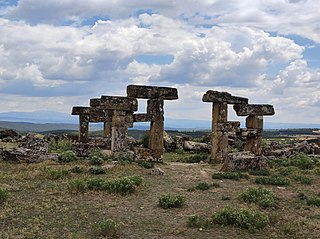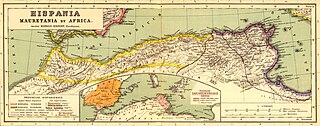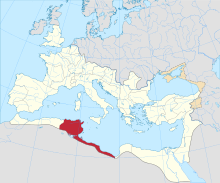Ruspe or Ruspae was a town in the Roman province of Byzacena, in Africa propria. It served as the episcopal see of Saint Fulgentius of Ruspe. It is now a Roman Catholic titular bishopric.

The city of Blaundus was the seat of a bishopric in the Roman and Byzantine era. It was a suffragan of the Metropolitan Archdiocese of Sardes, also in Lydia. It was part of the Patriarchate of Constantinople and was suffragan of Archdiocese of Sardis.

Blaundus was a Greek city founded during the Hellenistic period in Asia Minor, presently Anatolia, and is now a Latin Catholic titular bishopric.
Nicives, identifiable with N'Gaous in Batna Province, Algeria, was an ancient Roman town of the Roman province of Numidia.

The Diocese of Tubia is a suppressed and titular see in the province of Mauritania Caesariensis of the Roman Catholic Church. Tubia was a city in North Africa during the Roman, Byzantine and Vandal empires that is identifiable with the ruins of Henchir-Toubia.

Mutugenna or Muttegena was a colonia (town) of the Roman, Berber and Vandal empires, located in the Maghreb. The city is generally identified with the ruins at Ain-Tebla in modern Algeria. Mutugenna was also the locus of a bishopric and was an important site in the development of the Donatist schism.
Rotaria was an ancient Roman and Byzantine era bishopric of Numidia, North Africa.
Tigisis, also known as Tigisis in Mauretania to distinguish it from another Tigisis in Numidia, was an ancient Berber town in the province of Mauretania Caesariensis. It was mentioned in the Antonine Itinerary.

Thagamuta was a Roman–Berber city in the province of Byzacena. The location of the town is not definitively known, but it was on the plain of Guemouda in modern Tunisia.

Simidicca, was a Roman era civitas of the Roman province of Africa Proconsularis.

The Diocese of Sinnuara is a sede soppressa and titular see of the Roman Catholic Church. The bishopric is suffragan to the Archdiocese of Carthage.

The Diocese of Bennefa is a home suppressed and titular see of the Roman Catholic Church. Bennefa, identifiable with Oglet-Khefifa in modern Tunisia, is an ancient civitas of the Roman province of Byzacena. and a seat of an ancient Christian episcopal see. The diocese was mentioned by Augustine of Hippo.
Cabarsussi was an ancient civitas (municipality) and bishopric in the Roman province of Byzacena, that is tentatively identifiable with ruins at Drâa-Bellouan in modern Tunisia. The current bishop is Terence Robert Curtin, auxiliary bishop of Melbourne.

Forontoniana was a Roman town of the Roman province of Byzacena during late antiquity. The town has tentatively been identified with the ruins at Henchir-Bir-El-Menadla in modern Tunisia.
The Diocese of Fissiana is suppressed Latin Church diocese and current titular see of the Catholic Church.

Giru Mons is an ancient town of the Roman Empire and a titular bishopric of the Roman Catholic Church. The ancient town has been tentatively identified with ruins at Yerroum, northern Algeria.
Sicilibba was an ancient Roman town of the Roman province of proconsular Africa. The ancient town is tentatively identifiable with the ruins at Alaouine in today's Tunisia.

The diocese of Dionysiana is a suppressed and titular see of the Roman Catholic Church.
The diocese of Presidio is a suppressed and titular see of the Catholic Church.

The Diocese of Germa in Galatia or Germensis in Galatia is a suppressed see and now a titular see of the Roman Catholic Church. Its seat was at Germensis in Galatia in the province of Galatia in the civil diocese of Pontus. It formed part of the Patriarchate of Constantinople and was a suffragan see of the Archdiocese of Pessinus. Only one bishop of the see is known, Eustacius, who is mentioned as attending the Fourth Council of Constantinople in 879 which rehabilitated patriarch Photios I of Constantinople.







